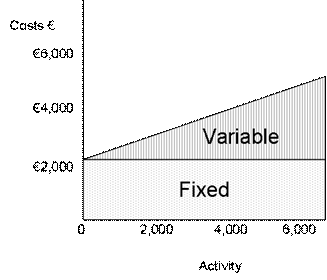a) Explain the term 'semi-variable costs' giving at least two examples.
Semi-variable costs are costs that have both a fixed and variable component. For example telephone charges include a rental cost, which would be considered fixed and the cost of the number of phone calls which could be considered variable. When one analyses these costs further, part of the 'phone call costs' could be considered fixed as the phone would be used even if sales were non-existent. Thus a phone bill would be considered predominantly fixed, with a variable element. Another example would be light and heat. In a restaurant light and heat is required even if there are no customers in the restaurant. However as the restaurant gets busier more cookers will be needed and this would be classified as the variable element. Thus light and heat could be considered a predominantly fixed cost with a variable element. The following diagram graphically presents a typical semi-variable cost pattern relating to a landline telephone charge.
Semi-variable cost patterns
................ 
b) Why is it necessary to distinguish between fixed and variable costs.
In trying to predict and plan for the future, it is essential to understand costs and what drives and creates costs. By classifying costs into a fixed or variable category management gain an insight into how costs will behave or react to changes in sales volume. When planning to increase output (sales volume), it is important to understand and appreciate how costs will react to this. Cost behaviour analysis focuses on how costs react to increases in sales volume. Fixed costs are those that do not react to sales volume fluctuations, whereas variable costs increase as sales volume increases. For example if a restaurant is expecting sales volume to increase then it must plan for certain costs to increase as well. These costs would be considered variable costs and would include such costs as food, beverages and part-time labour. Other costs such as fixed costs would not be expected to change as sales volume fluctuates. These costs would include rent, rates, depreciation, salaries, light and heat, advertising, and insurance. This distinction can help management plan and make decision for the future. The cost-volume-profit model (CVP) uses cost behaviour analysis to provide management with information with can support their planning and decision-making roles. This would include information relating to various strategies such as
- The forecast profit or loss
- The forecast break-even point
- The forecast number of products to be sold to make a required profit
- The forecast margin of safety
c) Classify the following expense items according to whether they are a fixed or variable cost.
Cost |
Fixed or variable |
Salary of restaurant supervisor |
Fixed |
Rent of shop unit |
Fixed |
Depreciation of computer reservation system |
Fixed |
Sales commission |
Variable |
Purchase of goods for resale in a shop |
Variable |
Paint for each product |
Variable |
Oil for central heating system |
Fixed |
Home delivery service costs for supermarket |
Variable |
Cashiers wages |
Fixed |
Facilities managers salary |
Fixed |